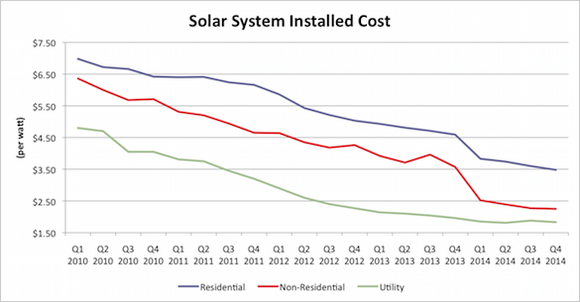How Bill Gates Has Gotten Energy All Wrong

Bill Gates built a fortune that's approaching $100 billion on the back of his incredible innovative and business genius at Microsoft (MSFT). He's now turned his attention to helping the world through the Bill and Melinda Gates Foundation, giving money away and investing in other innovative companies that could improve the world for everyone.
One such company Gates has been supporting for nearly a decade is TerraPower, a next-generation nuclear power company. But TerraPower is quickly falling behind more competitive energy sources and Gates could be left in the dust by the time he can even prove his nuclear vision has legs.
The Problem With Nuclear Energy Today
It's fun to talk about nuclear power like it could save the world, but the reality is that it's one of the most expensive forms of energy we have today. According to a study by investment bank Lazard, it would cost more to build a nuclear plant today than it would to build a plant for natural gas, wind, solar and in some places even coal.
The problem with nuclear energy can be seen in the U.S. today. The Vogtle nuclear expansion in Georgia is slated to cost $14 billion and has been delayed by at least three years. Even Georgia Power estimates that when it's completed, customers' rates will go up 6 to 8 percent, on top of the hundreds of millions in rate-based payments they've already paid for the plant while it's been under construction.
That's a plant that has a design that we at least know is feasible. Gates is betting on technology that TerraPower is hoping to prove in a pilot plant in the "mid-2020s" -- 10 years from now. Meanwhile, the technology Gates called "cute" four years ago is disrupting everything we know about energy.
Missing the Solar Bandwagon
While the cost of nuclear energy continues to rise, the cost of solar energy continues to drop and at rates that defy all predictions. The cost to install a utility-scale solar project has dropped 62 percent in the last five years and a residential project now costs half of what it cost at the start of 2010.

To put solar's cost in perspective: Companies like SolarCity (SCTY) and SunPower (SPWR) are now selling power from rooftop solar systems to consumers for lower costs per kilowatt than what they pay for electricity from the grid. On an even larger scale, utility-scale projects are now being built with power purchase agreements of 6 cents a kwh or less. To put that wholesale cost into perspective, if you live in New England, you're paying an average of 21 cents a kwh for electricity in your home and the national average is 12.3 cents a kwh. And those wholesale costs are beating natural gas, coal and nuclear in competitive market bidding.
Ironically, what Gates, and many others, have missed is the rapid rate of innovation happening in energy today. But we're not talking about innovation in nuclear plants, which takes decades; we're talking about innovation that can go from idea to reality in a matter of months.
The Rate of Innovation Matters
One major reason I think Gates has the future of energy all wrong is the fact that nuclear energy is so slow to innovate, and some incredible innovations are coming out of new industries, like wind and solar.
%VIRTUAL-WSSCourseInline-742%I already talked about the cost of solar but look at what's happening on the energy storage side as well. One problem with wind and solar energy in the past was its intermittency when the wind isn't blowing or the sun isn't out. This variability makes it a poor source of base load power that can be on at all times, like a natural gas or coal plant. But Elon Musk's Powerwall and Power Packs, along with dozens of other competitors, are answering that problem by allowing homeowners and utilities to store a few hours' worth of electricity to reduce the impact of intermittency, provide backup power, or lower the overall cost to run the grid. As storage technology improves, it will likely be an economical addition to wind and solar, and could be a standard component of a home solar installation.
You could potentially have a solar system on your roof with battery backup by 2020. Gates won't even have a new nuclear pilot plant up and running by that point.
Where we source energy from is changing faster than at any point in history and the companies that can innovate quickly will be standing strong in the future -- while companies who are betting on technologies that are a decade away will be left in the dust. Sorry, Mr. Gates. The energy source you once thought was "cute" is now making your nuclear power dream a nightmare.
Motley Fool contributor Travis Hoium owns shares of SunPower. The Motley Fool recommends and owns shares of SolarCity and Tesla Motors. Try any of our Foolish newsletter services free for 30 days. Prepare your portfolio for the future: Check out our free report on one great stock to buy for 2015 and beyond.

